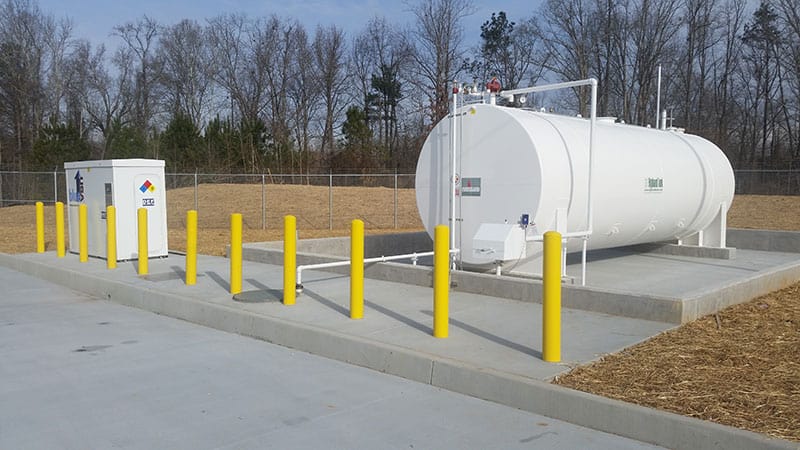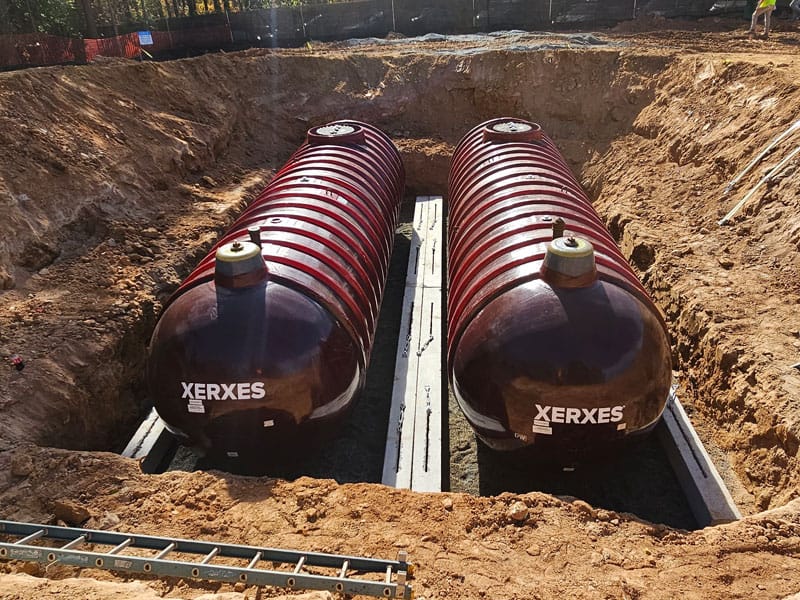Choosing the Right Fuel Storage Tank is based on Several Considerations Including Available Space, Budget, Regulations, Secondary Containment, Material, and Serviceability
In this Pumped Up blog, we investigate the differences between above ground and underground fuel storage tanks. The fuel tank is a critical component in fueling system design.
Commercial and fleet fueling systems today can be designed in many ways to accomplish very specific purposes for the end user. The fuel system that works best for a transit bus operation may not be ideal for a county school system operating a fleet of school buses. A fuel system for a small municipal police department is not adequate for a metropolitan county’s public works department.
The primary differences between aboveground and underground fuel storage tanks are detailed below. Each type of storage tank has its own pros and cons. Other considerations when choosing a fuel storage tank include monthly throughput, tank capacity, the number of fueling positions and even redundancy.
Underground Fuel Storage Tanks are Typically Better When Space is Limited
The first consideration when choosing a fuel storage tank is available space. If you’re considering an aboveground tank (commonly referred to as an AST), your property must have enough space for it. If space is at a premium, such as in urban areas, an underground tank (commonly referred to as a UST) may be the better option.
Underground Fuel Storage Tanks Are More Heavily Regulated
Aboveground fuel storage tanks are closely regulated by the state and local fire marshals who generally use the National Fire Protection Association (NFPA) 30 and 30A codes to determine the safe distances from neighboring properties, roads, and buildings. Underground tanks generally allow more flexibility in placement within a property, but are heavily regulated by the US EPA, and in Georgia, the Georgia Environmental Protection Division (GA EPD). UST Regulations typically involve monthly, annual, and triennial testing and inspections that should be performed by trained and certified
petroleum testers. UST Compliance generally has a higher level of records retention and reporting requirements which can become difficult to manage for larger organizations where multiple parties may share the responsibility.
Underground Fuel Storage Tanks Can Cost More – But it Depends
When calculating the cost of a fuel storage tank, it should include both the cost of the tank itself and installation. Aboveground fuel storage tanks are generally more expensive than a similar sized underground fuel storage tank depending on the material and type of tank.
Installation costs can vary widely, but in general it is less expensive to install aboveground tanks with only minor excavation needed for tank footings and piping and electrical trenches. The installation of underground tanks requires much more planning, including logistics for disposing of excavated soils, shoring the excavation in some situations, and
dewatering the excavation in areas with a high water table. A geotechnical survey is a great way to determine what soil type to expect and to determine if there is any potential for hitting rock during excavation which can increase the costs substantially.
Secondary Containment is Critical for Both Aboveground and Underground Fuel Storage Tanks
Secondary containment is important for both ASTs and USTs, with monitoring systems available to detect leaks in the primary tank by monitoring for the presence of fuel in the secondary or interstitial space of the tank. In AST systems, secondary containment can be as simple as a concrete dike wall surrounding the tank and designed to contain up to 110% of the largest tank’s capacity. In most UST systems, secondary containment is achieved by building double walled tanks with an inner and outer tank shell, and with access to install a leak sensor in the interstitial space.
Underground Fuel Storage Tanks Require Protection Against Corrosion
The material used to construct your fuel storage tank is another key consideration. Most aboveground fuel storage tanks are built with mild steel and coated with an epoxy based paint. They can be built with epoxy internal coatings to inhibit internal corrosion as well.
Underground fuel storage tanks are commonly built from mild steel with specialized outer coatings such as fiberglass jackets or can be built entirely of fiberglass. Because UST’s are in direct contact with the soil, special care must be taken to ensure corrosion does not compromise the integrity of the tank which could lead to a release of petroleum product into the soil. Steel tanks should be coated or jacketed, and any steel components in contact with the soil should be protected by galvanic or impressed current cathodic protection systems. Fiberglass tanks in general do not need any corrosion prevention measures, but care should still be taken to protect tank components such as steel pipe risers.
Underground Fuel Storage Tanks Are More Difficult to Service if the Problem is Below Grade
One design consideration often omitted is the serviceability of the system. AST systems can be simple and easy to service because most components can be easily accessed for testing, inspections and repairs. A drawback to aboveground tanks is their sheer size, often 8ft or 10ft in diameter, with pumps and valve components well over 12ft above grade level. Due to the height above ground, servicing an AST can often require ladders, lifts and fall protection equipment and should always be done with at least two technicians for safety.
On the other hand, underground fuel storage tanks are easier to access for routine service such as replacing sensors and servicing submersible pumps, but can be more costly to repair when components below grade need to be excavated to be repaired or replaced. A drawback to underground tanks is the increased requirement for containment sumps below grade which can be a collection point for surface water runoff. Once rainwater enters a petroleum containment sump, it should be considered petroleum contact water, or PCW, which must be properly removed and disposed by a licensed treatment facility designed to separate the petroleum from the water for recycling. New UST systems can be designed
and installed to prevent water intrusion, while older systems should be retrofitted with watertight manholes and sump lids to limit water intrusion. The cost of water intrusion can be significant, especially when water finds its way into the fuel itself, contaminating the fuel and creating a breeding ground for algae which can lead to corrosion of metallic components in the tank system.
For More Information
If you are planning a new fueling facility for your vehicle fleet, marina, airport or emergency generator system, contact United Pump at 770-662-0440 or travis@unitedpump.com. For over 50 years, we have provided designed, installed and serviced petroleum equipment including fuel storage tanks, gas pumps, fuel dispensing systems and more. Our industry experts can help size and specify your fueling system to ensure it meets all your needs, now and in the future.


